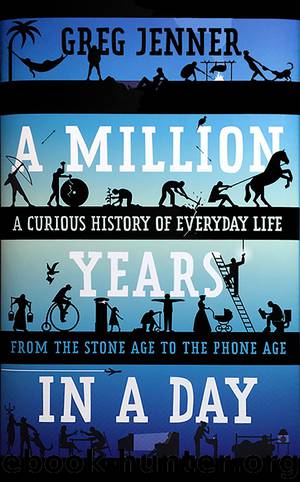A Million Years in a Day by Greg Jenner

Author:Greg Jenner
Language: eng
Format: epub
ISBN: 9781250089441
Publisher: St. Martin's Press
WE ARE LIVING IN A MATERIAL WORLD
In 1881, a man named Mohammed al-Rassul betrayed his two brothers. For the previous decade, the trio had been illegally flogging ancient Egyptian antiquities from a secret tomb which they‘d stumbled upon when chasing down an errant goat (as you do…). But after suspicions were raised by officials, and an investigation led to the brothers, al-Rassul decided to shop in his two siblings and claim the reward for himself. Such betrayal suggests he had a crappy personality, but the world was undoubtedly grateful to him when he led archaeologists to the site of more than 50 ancient mummies, including that of the greatest of all the Pharaohs – King Ramesses II.
But, how’s this relevant to clothing? Well, Ramesses was wrapped in perfectly preserved linen, a fabric woven from the flax plant – one possibly worn as far back as 30,000 years ago – and it was the Egyptians who really took to linen because it’s a cool, lightweight fabric which can be easily bleached back to its pleasing creamy tone. More importantly, it was hygienic in a culture that prized cleanliness. Ramesses may have been a semi-divine king, but he wasn’t shrouded in gorgeous silks, velvets and furs; no, his funerary garb was the same as that of any plough-wielding peasant smeared in ox shit. Linen was for everyone.
And, as we now know, linen shirts and slips were also the most common type of underwear in seventeenth-century Europe, where the fact they could be regularly rotated, and laundered clean, was much preferred over applying soap and water to the body itself. Crucially, though, when washing made its big comeback, linen didn’t go quietly into the night, and many a Victorian housemaid found herself engaged in a never-ending battle to keep clothes and bedding looking white. These days, we tend to wear less of it, and prefer to stretch it over tables and mattresses rather than our shoulder blades, but it still goes everywhere with us, lurking in our wallets, because linen – along with cotton – is a constituent part in some modern banknotes. That doesn’t mean you can put them through the washing machine, though … ‘Money laundering’ isn’t a literal thing.
Cotton, of course, is also an ancient fabric. When Herodotus wrote ‘And further [In India], there are trees which grow … a wool exceeding in beauty and goodness that of sheep. The natives make their clothes of this tree-wool’, he was describing a custom already two millennia older than him, and that’s really saying something because he was an ancient Greek who died 2,400 years ago. So, who were these Bronze Age cotton farmers? No prizes for guessing that it was those trendsetting Harappans who began cotton’s journey to becoming the most influential fabric in world history. But cotton wasn’t just confined to Asia, as it was also the primary fabric of the advanced South and Central American cultures, such as the Incas and Aztecs, the latter of whom – not possessing
Download
This site does not store any files on its server. We only index and link to content provided by other sites. Please contact the content providers to delete copyright contents if any and email us, we'll remove relevant links or contents immediately.
Learning SQL by Alan Beaulieu(5418)
Weapons of Math Destruction by Cathy O'Neil(5043)
iGen by Jean M. Twenge(4703)
Digital Minimalism by Cal Newport;(4557)
Sapiens by Yuval Noah Harari(4545)
Elon Musk by Ashlee Vance(3457)
The Age of Surveillance Capitalism by Shoshana Zuboff(3429)
Thing Explainer by Randall Munroe(3333)
Apollo 8 by Jeffrey Kluger(3204)
Future Crimes by Marc Goodman(3005)
The Science Book (Big Ideas Simply Explained) by DK(2748)
Who Can You Trust? by Rachel Botsman(2733)
I Live in the Future & Here's How It Works by Nick Bilton(2529)
Infinite Energy Technologies by Finley Eversole(2494)
Dawn of the New Everything by Jaron Lanier(2441)
Steve Jobs by Walter Isaacson(2438)
Chernobyl by Serhii Plokhy(2129)
Energy Myths and Realities by Vaclav Smil(2064)
Ben Franklin's Almanac by Candace Fleming(2060)
